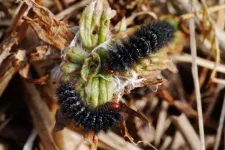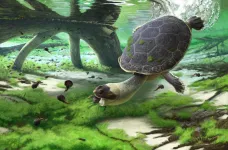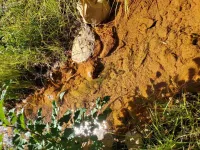Small things can have a major effect on the prevention of biodiversity loss
2021-05-05
(Press-News.org) The population growth of an endangered butterfly species is greatest in habitats with microclimatic variability, demonstrates a study carried out collaboratively by the Faculty of Biological and Environmental Sciences and the Helsinki Institute of Life Science of the University of Helsinki as well as the Finnish Environment Institute.
Insects are often very restricted in their capacity for movement. In many species, specific stages of life are spent entirely immobile, making them dependent on the temperature and moisture conditions of their immediate surroundings. In the Åland Islands on the southwest coast of Finland, Glanville fritillary butterflies (Melitaea cinxia) spend roughly 10 months of the year in the larval stage. In the middle of summer, the newly hatched larvae eat, as a group, the host plant, on whose leaf the female happened to lay the eggs. Prior research has shown that plants can wither entirely in dry summers, with prolonged dry periods sealing the fate of butterfly larvae. In such cases, only those larvae survive whose eggs have been laid on a plant growing in an exceptionally moist spot.
"We investigated how varying microclimates affect larval growth and survival in the spring after the overwintering. We found that warm and sunny days in March woke up the larvae and made them look for food. However, very little food was to be found, since the few warm days in early spring were followed by a cool April, with the growing season of the larval host plants only beginning in earnest in May," says doctoral researcher Susu Rytteri from the University of Helsinki's Research Centre for Ecological Change. She defended her thesis at the end March 2021.
It was observed that, in sunny and warm microclimates, larvae grew faster but also perished in large numbers because of lack of food. In cooler and shadier microclimates, larval growth was slow, a boost to the sufficiency of food: food plants had the time to grow in sync with the nutritional requirements of the larvae. Comprehensive survey data from the Åland Islands also demonstrated that Glanville fritillary populations grew the most in meadows where their larvae inhabited varying microclimates.
"The growth of butterfly populations increased when larval groups were located in particularly warm spots on sunny southward slopes. At the same time, the larvae also benefited from cooler and shaded microclimates. Due to the unpredictability and variability of weather conditions, the optimal egg-laying strategy for insects would appear to be laying eggs in varying microclimates which have the capacity to protect their immobile offspring from unfavourable conditions. The problem is that habitats have declined in number and become increasingly uniform. Consequently, varying microclimates are not necessarily on offer," Rytteri says.
More microclimatic variability in yards and gardens
Promoting microclimatic variability in your backyard helps insects and other animals. The sunniest spot in the yard can be turned into an even warmer place for sunbathing by, for example, constructing a section of stone wall that stores heat and offers protective crevices for small creatures. An oasis in the shade can be built in the coolest location in the yard by planting lush plants that thrive away from the sun and by adding a water element that is not only pleasing to the human eye but also serves as a watering place for animals during dry spells.
"Butterflies benefit from diverse plants, and in butterfly gardens, the goal should be floral splendour stretching from early spring long into the autumn. Many garden plants are good melliferous plants, that is, plants rich in pollen and nectar, but wild meadow plants shouldn't be overlooked either. Trees, bushes, rocks and knolls form variable microclimates and offer protection from unfavourable weather conditions," Rytteri points out.
INFORMATION:
[Attachments] See images for this press release:

ELSE PRESS RELEASES FROM THIS DATE:
2021-05-05
Researchers from University of Texas-Austin and Copenhagen Business School published a new paper in the Journal of Marketing that offers actionable guidance to managers on the deployment of algorithms in marketing contexts.
The study, forthcoming in the Journal of Marketing, is titled "When Algorithms Fail: Consumers' Responses to Brand Harm Crises Caused by Algorithm Errors" and is authored by Raji Srinivasan and Gulen Sarial-Abi.
Marketers increasingly rely on algorithms to make important decisions. A perfect example is the Facebook News Feed. You do not know why some of your posts show up on some people's News Feeds or not, but Facebook does. Or how about Amazon recommending books and products for you? All of these are driven by algorithms. Algorithms are software ...
2021-05-05
BATON ROUGE, Louisiana - Stress levels of moms with preschoolers soared during the pandemic, with twice as many of the mothers reporting they lost sleep during the COVID-19 outbreak than before it.
"Moms of young children are already less likely to get the recommended amount of sleep and physical activity than women who don't have children. These shortfalls could raise the risk for obesity and poor health, and the lockdown worsened the situation by increasing the levels of stress and household chaos," said Chelsea Kracht, Ph.D., a Postdoctoral Researcher in the Pediatric Obesity and Health Behavior Laboratory at Pennington Biomedical Research Center.
The bottom line? "Mothers, especially ...
2021-05-05
Joyce WG, Rollot Y, Evers SW, Lyson TR, Rahantarisoa LJ, Krause DW. 2021. A new pelomedusoid turtle, Sahonachelys mailakavava, from the Late Cretaceous of Madagascar provides evidence for convergent evolution of specialized suction feeding among pleurodires. Royal Society Open Science 8:210098. https://doi.org/10.1098/rsos.210098
First author: Prof. Dr. Walter Joyce (walter.joyce@unifr.ch), Professor of Paleontology, University of Fribourg, Switzerland
Co-authors:
- Yann Rollot (yann.rollot@unifr.ch), PhD student, University of Fribourg, Switzerland
- Serjsocha Evers (serjoscha.evers@unifr.ch; preferred: serjoscha.evers@googlemail.com), ...
2021-05-05
Researchers have discovered the most precise way to control individual ions using holographic optical engineering technology.
The new technology uses the first known holographic optical engineering device to control trapped ion qubits. This technology promises to help create more precise controls of qubits that will aid the development of quantum industry-specific hardware to further new quantum simulation experiments and potentially quantum error correction processes for trapped ion qubits.
"Our algorithm calculates the hologram's profile and removes any aberrations from the light, which lets us develop a highly precise technique for programming ...
2021-05-05
A computer science engineer at Michigan State University has a word of advice for the millions of bitcoin owners who use smartphone apps to manage their cryptocurrency: don't. Or at least, be careful. Researchers from MSU are developing a mobile app to act as a safeguard for popular but vulnerable "wallet" applications used to manage cryptocurrency.
"More and more people are using bitcoin wallet apps on their smartphones," said Guan-Hua Tu, an assistant professor in MSU's College of Engineering who works in the Department of Computer Science and Engineering. "But these applications have vulnerabilities." ...
2021-05-05
A new USC study suggests that certain neighborhoods - particularly those characterized by poverty and unemployment - may pose an environmental risk to the developing brains of children, impacting neurocognitive performance and even brain size.
The research was published May 3 in the journal JAMA Pediatrics.
These findings highlight the importance of neighborhood environments for child and adolescent brain development, the researchers said, and suggest that policies, programs and investments that help improve local neighborhood conditions and empower communities could support children's neurodevelopment and long-term health.
"This is the first large, national study ...
2021-05-05
Using a bit of machine learning magic, astrophysicists can now simulate vast, complex universes in a thousandth of the time it takes with conventional methods. The new approach will help usher in a new era in high-resolution cosmological simulations, its creators report in a study END ...
2021-05-05
Many miles of streams and rivers in the United States and elsewhere are polluted by toxic metals in acidic runoff draining from abandoned mining sites, and major investments have been made to clean up acid mine drainage at some sites. A new study based on long-term monitoring data from four sites in the western United States shows that cleanup efforts can allow affected streams to recover to near natural conditions within 10 to 15 years after the start of abatement work.
The four mining-impacted watersheds--located in mountain mining regions of California, Colorado, Idaho, and Montana--were all designated as Superfund sites under the Comprehensive Environmental Response, Compensation, and Liability Act (CERCLA), which helps ...
2021-05-05
A universe evolves over billions upon billions of years, but researchers have developed a way to create a complex simulated universe in less than a day. The technique, published in this week's Proceedings of the National Academy of Sciences, brings together machine learning, high-performance computing and astrophysics and will help to usher in a new era of high-resolution cosmology simulations.
Cosmological simulations are an essential part of teasing out the many mysteries of the universe, including those of dark matter and dark energy. But until now, researchers faced the common conundrum of not being ...
2021-05-05
As pandemic lockdowns went into effect in March 2020 and millions of Americans began working from home rather than commuting to offices, heavy traffic in America's most congested urban centers--like Boston--suddenly ceased to exist. Soon afterwards, the air was noticeably cleaner. But that wasn't the only effect. A team of Boston University biologists who study how human-related sounds impact natural environments seized the opportunity to learn how the reduced movement of people would impact local ecosystems. They found--surprisingly--that sound levels increased in some nature conservation areas, a result of cars driving faster on roads no longer choked by traffic.
BU ecologist Richard Primack and Carina Terry, an undergraduate student working in Primack's ...
LAST 30 PRESS RELEASES:
[Press-News.org] Small things can have a major effect on the prevention of biodiversity loss







